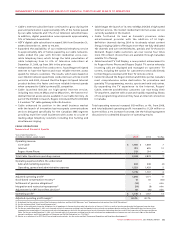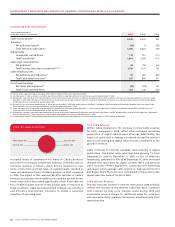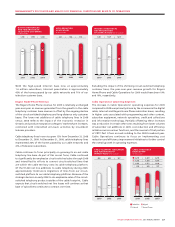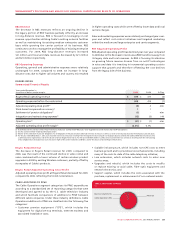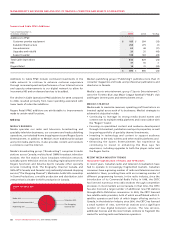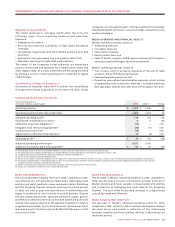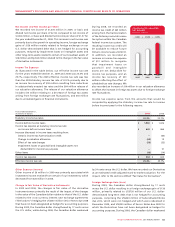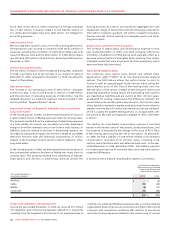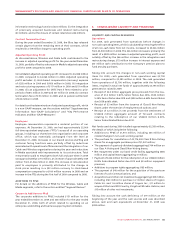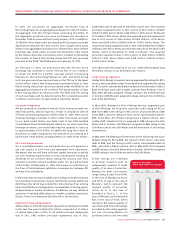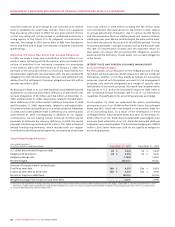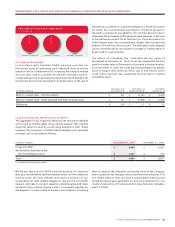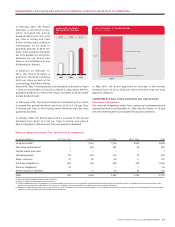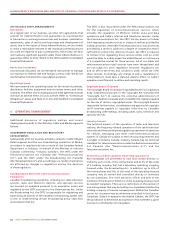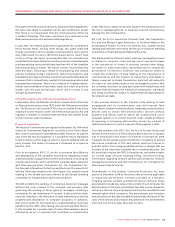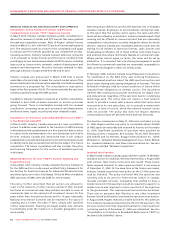Rogers 2009 Annual Report Download - page 40
Download and view the complete annual report
Please find page 40 of the 2009 Rogers annual report below. You can navigate through the pages in the report by either clicking on the pages listed below, or by using the keyword search tool below to find specific information within the annual report.
44 ROGERS COMMUNICATIONS INC. 2009 ANNUAL REPORT
MANAGEMENT’S DISCUSSION AND ANALYSIS OF FINANCIAL CONDITION AND RESULTS OF OPERATIONS
by 24 cents versus the U.S. dollar resulting in a foreign exchange
loss of $99 million, primarily related to the US$750 million of
U.S. dollar-denominated long-term debt that is not hedged for
accounting purposes.
Debt Issuance Costs
We recorded debt issuance costs of $11 million during 2009 due to
the transaction costs incurred in connection with the $2.0 billion of
issuances, including the $1.0 billion of 5.80% Senior Notes due 2016
issued on May 26, 2009 and the $500 million of 5.38% Senior Notes
due 2019 and $500 million of 6.68% Senior Notes due 2039 issued on
November 4, 2009.
Interest on Long-Term Debt
The $72 million increase in interest expense during 2009, compared
to 2008, is primarily due to the increase in our long-term debt at
December 31, 2009, compared to December 31, 2008, including the
impact of Derivatives.
Operating Income
The increase in our operating income of $544 million, compared
to the prior year, is due to the growth in revenue of $396 million
and the reduction of operating expenses of $148 million. See the
detailed discussion on respective segment results included in this
section entitled “Segment Review” above.
Impairment Losses on Goodwill, Intangible Assets and Other
Long-Term Assets
In the fourth quarter of 2009, we determined that the fair value of
a radio station licence of Media was lower than its carrying value.
This primarily resulted from the weakening of advertising revenues
in a local market. As a result, we recorded a non-cash impairment
charge of $4 million related to one of our Ontario radio licences. In
addition, and also related to declines in advertising revenue, we
recorded an impairment charge of $14 million related to our OMNI
television network with the following components: $1 million
related to the broadcast licences and $13 million related to other
long-lived assets.
In the fourth quarter of 2008, we determined that the fair value of
the conventional television business of Media was lower than its
carrying value. This primarily resulted from weakening of industry
expectations and declines in advertising revenues amidst the
slowing economy. As a result, we recorded an aggregate non-cash
impairment charge of $294 million with the following components:
$154 million related to goodwill, $75 million related to broadcast
licences and $65 million related to intangible assets and other
long-term assets.
Depreciation and Amortization Expense
The increase in depreciation and amortization expense for the
year ended December 31, 2009, over 2008, primarily reflects the
$1.9 billion of additions to PP&E during 2009, partially offset by a
decrease in amortization of intangible assets resulting from certain
intangible assets that were acquired in the Fido acquisition, which
have now been fully amortized.
Stock-based Compensation
Our employee stock option plans attach cash settled share
appreciation rights (“SARs”) to all new and previously granted
options. The SAR feature allows the option holder to elect to
receive in cash an amount equal to the intrinsic value, being the
excess market price of the Class B Non-Voting share over the
exercise price of the option, instead of exercising the option and
acquiring Class B Non-Voting shares. All outstanding stock options
are classified as liabilities and are carried at their intrinsic value,
as adjusted for vesting, measured as the difference between the
current stock price and the option exercise price. The intrinsic value
of the liability is marked-to-market each period and is amortized to
expense over the period in which the related services are rendered,
which is usually the graded vesting period, or, as applicable, over
the period to the date an employee is eligible to retire, whichever
is shorter.
The liability for stock-based compensation expense is recorded
based on the intrinsic value of the options, as described above, and
the expense is impacted by the change in the price of RCI’s Class
B Non-Voting shares during the life of the option. At December
31, 2009, we had a liability of $178 million related to stock-based
compensation recorded at its intrinsic value, including stock
options, restricted share units and deferred share units. In the year
ended December 31, 2009, $63 million (2008 – $106 million) was paid
to holders upon exercise of restricted share units and stock options
using the SAR feature.
A summary of stock-based compensation expense is as follows:
Stock-based Compensation
Expense (Recovery) Included
in Operating, General and
Administrative Expenses
Years ended December 31,
(In millions of dollars) 2009 2008
Wireless $ – $ (5)
Cable (12) (32)
Media (8) (17)
Corporate (13) (46)
$ (33) $ (100)
Integration and Restructuring Expenses
During the year ended December 31, 2009, we incurred $117 million
of integration and restructuring expenses related to: i) severances
resulting from the targeted restructuring of our employee base to
combine our Cable and Wireless businesses into a communications
organization and to improve our cost structure in light of the current
economic and competitive conditions ($87 million); ii) severances
and restructuring expenses related to the outsourcing of certain



